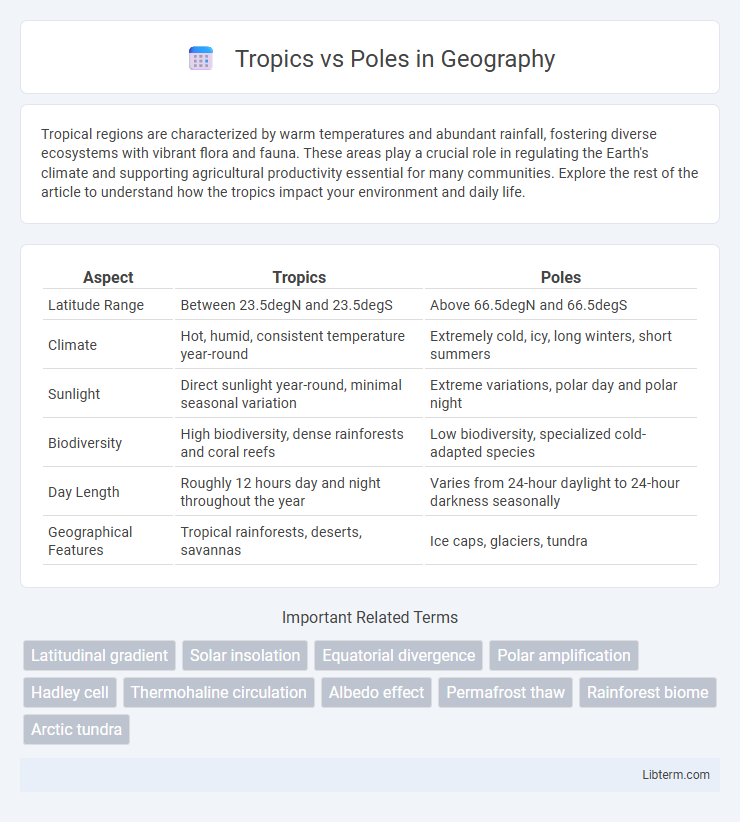Tropical regions are characterized by warm temperatures and abundant rainfall, fostering diverse ecosystems with vibrant flora and fauna. These areas play a crucial role in regulating the Earth's climate and supporting agricultural productivity essential for many communities. Explore the rest of the article to understand how the tropics impact your environment and daily life.
Table of Comparison
| Aspect | Tropics | Poles |
|---|---|---|
| Latitude Range | Between 23.5degN and 23.5degS | Above 66.5degN and 66.5degS |
| Climate | Hot, humid, consistent temperature year-round | Extremely cold, icy, long winters, short summers |
| Sunlight | Direct sunlight year-round, minimal seasonal variation | Extreme variations, polar day and polar night |
| Biodiversity | High biodiversity, dense rainforests and coral reefs | Low biodiversity, specialized cold-adapted species |
| Day Length | Roughly 12 hours day and night throughout the year | Varies from 24-hour daylight to 24-hour darkness seasonally |
| Geographical Features | Tropical rainforests, deserts, savannas | Ice caps, glaciers, tundra |
Introduction to Tropical and Polar Regions
Tropical regions, located between the Tropic of Cancer and the Tropic of Capricorn, experience consistently high temperatures and significant solar radiation year-round, fostering rich biodiversity and dense rainforests. Polar regions, situated near the Arctic and Antarctic Circles, endure extreme cold, ice-covered landscapes, and prolonged periods of darkness or daylight, supporting specialized ecosystems adapted to harsh climatic conditions. Understanding the climatic and ecological distinctions between tropics and poles highlights their unique roles in Earth's environmental system.
Climate Differences: Tropics vs Poles
The Tropics experience consistently high temperatures year-round, with average annual temperatures typically above 18degC (64degF) and abundant solar radiation driving intense humidity and frequent precipitation patterns. In contrast, the Poles endure extreme cold, with average annual temperatures often below -30degC (-22degF) due to low solar angles and prolonged periods of darkness in winter, resulting in ice-covered landscapes and minimal precipitation. These climatic disparities between the Tropics and Poles influence global weather patterns, biodiversity distribution, and the Earth's energy balance.
Biodiversity Contrast: Rainforests and Polar Ecosystems
Tropical rainforests harbor unparalleled biodiversity, containing over half of Earth's terrestrial species, including countless endemic plants, insects, and vertebrates adapted to warm, humid environments. In contrast, polar ecosystems are characterized by extreme cold and seasonal darkness, supporting fewer species such as polar bears, penguins, and cold-adapted microbes specialized for survival in ice-covered regions. This stark biodiversity contrast highlights the richness of tropical habitats versus the resilience required for life in polar biomes.
Sunlight Exposure and Seasonal Variations
The Tropics receive consistent, direct sunlight year-round, resulting in minimal seasonal variations and stable temperatures. In contrast, the Poles experience extreme seasonal variations with prolonged sunlight during summer and complete darkness in winter due to the Earth's axial tilt. Sunlight exposure in the Poles leads to drastic temperature fluctuations, creating harsh and variable climates, unlike the steady warmth in tropical regions.
Human Adaptation in Tropics and Polar Zones
Human adaptation in the tropics involves physiological traits such as increased sweating efficiency and melanin-rich skin to protect against intense solar radiation, while cultural adaptations include lightweight clothing and housing designed for ventilation. In polar zones, humans exhibit adaptations like enhanced basal metabolic rates, increased subcutaneous fat for insulation, and specialized clothing made from animal hides to retain heat. Both regions demonstrate distinct evolutionary and cultural strategies to mitigate environmental stressors like extreme temperatures and solar exposure.
Ecosystem Services: Tropical vs Polar Contributions
Tropical ecosystems provide critical services such as carbon sequestration, biodiversity support, and climate regulation due to their dense forests and high biological productivity, contributing significantly to global oxygen generation and freshwater cycling. In contrast, polar ecosystems, despite their lower biodiversity, offer unique ecosystem services including climate regulation through ice-albedo effects, carbon storage in permafrost, and support for migratory species adapted to extreme conditions. Both regions play complementary roles in the Earth's system, with tropics driving biomass-related services and poles regulating planetary temperature and sea-level stability.
Impact of Climate Change on Tropics and Poles
Climate change causes rapid temperature increases in the Arctic, leading to melting ice caps and disrupting polar ecosystems, while the tropics experience intensified heatwaves, altered rainfall patterns, and rising sea levels affecting biodiversity and agriculture. The poles face permafrost thawing that releases methane, accelerating global warming, whereas tropical regions endure stronger cyclones and coral bleaching that threaten marine life and livelihoods. These contrasting impacts underscore the vulnerability of both regions to climate change-induced environmental and socio-economic challenges.
Economic Activities Unique to Each Region
The Tropics host agriculture centered on crops like coffee, cocoa, and sugarcane due to their warm, humid climate, supporting economies reliant on plantation farming and ecotourism. In contrast, the Poles emphasize resource extraction such as oil, natural gas, and minerals, alongside scientific research stations that contribute to global climate studies. Fishing and shipping industries are vital in both regions but differ in species and operational methods influenced by their distinct climates.
Challenges in Conservation: Tropical and Polar Perspectives
Conservation challenges in the tropics involve biodiversity loss due to deforestation, habitat fragmentation, and high species endemism, requiring urgent protection of rainforests and coral reefs. Polar regions face threats from climate change-induced ice melt, disrupting habitats for species like polar bears and penguins, and complicating marine conservation efforts. Both regions demand specialized strategies to address distinct ecological vulnerabilities while balancing human activities and environmental protection.
Future Outlook: Tropics and Poles in a Changing World
The future outlook for the tropics and poles highlights divergent climate impacts driven by global warming, with polar regions experiencing accelerated ice melt and rising sea levels, while tropical areas face intensified heatwaves, biodiversity loss, and shifting precipitation patterns. Melting polar ice threatens coastal communities worldwide and disrupts ocean circulation, exacerbating climate instability. In contrast, tropical zones' vulnerability to extreme weather events and habitat degradation necessitates urgent adaptation and mitigation strategies to safeguard ecosystems and human livelihoods.
Tropics Infographic

 libterm.com
libterm.com